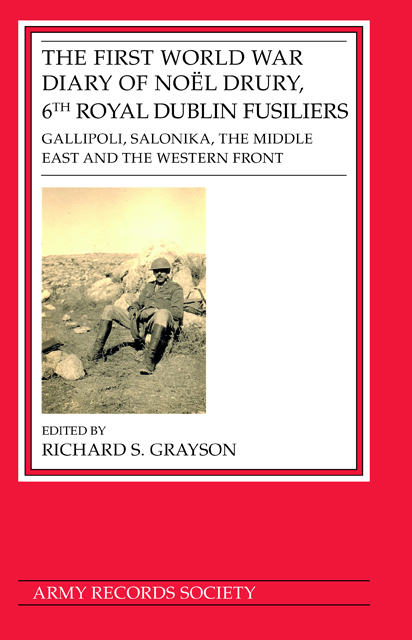 First World War Diary of Noël Drury, 6th Royal Dublin Fusiliers
First World War Diary of Noël Drury, 6th Royal Dublin Fusiliers Book contents
- Frontmatter
- Miscellaneous Frontmatter
- Contents
- List of Illustrations
- Acknowledgements
- List of Abbreviations
- Introduction
- 1 Volunteering and Training, September 1914–July 1915
- 2 The Voyage to the Dardanelles, July–August 1915
- 3 Gallipoli: Landing at Suvla Bay and the Next Ten Days, 7–17 August 1915
- 4 Gallipoli: Digging In, 18 August–October
- 5 The Serbian Front and the Battle of Kosturino, October–December 1915
- 6 The Salonika Front and Hospital, December 1915–September 1917
- 7 Egypt and Palestine, September–December 1917
- 8 Defending Jerusalem and the Battle of Tell ‘Asur, December 1917–July 1918
- 9 France, July–11 November 1918
- 10 Armistice, 12 November 1918– 11 March 1919
- Appendix 1 6th Royal Dublin Fusiliers leaving home for service overseas, 10 July 1915
- Appendix 2 The Effects of the Gallipoli Campaign on the 6th Royal Dublin Fusiliers
- Appendix 3 Officers of the 6th Royal Dublin Fusiliers at Hastière-sur-Meuse, Nov 1918
- Biographies
- Bibliography
- Index
1 - Volunteering and Training, September 1914–July 1915
Published online by Cambridge University Press: 14 June 2023
- Frontmatter
- Miscellaneous Frontmatter
- Contents
- List of Illustrations
- Acknowledgements
- List of Abbreviations
- Introduction
- 1 Volunteering and Training, September 1914–July 1915
- 2 The Voyage to the Dardanelles, July–August 1915
- 3 Gallipoli: Landing at Suvla Bay and the Next Ten Days, 7–17 August 1915
- 4 Gallipoli: Digging In, 18 August–October
- 5 The Serbian Front and the Battle of Kosturino, October–December 1915
- 6 The Salonika Front and Hospital, December 1915–September 1917
- 7 Egypt and Palestine, September–December 1917
- 8 Defending Jerusalem and the Battle of Tell ‘Asur, December 1917–July 1918
- 9 France, July–11 November 1918
- 10 Armistice, 12 November 1918– 11 March 1919
- Appendix 1 6th Royal Dublin Fusiliers leaving home for service overseas, 10 July 1915
- Appendix 2 The Effects of the Gallipoli Campaign on the 6th Royal Dublin Fusiliers
- Appendix 3 Officers of the 6th Royal Dublin Fusiliers at Hastière-sur-Meuse, Nov 1918
- Biographies
- Bibliography
- Index
Summary
All those who joined the British forces in Ireland during the First World War did so voluntarily. There was never any conscription, as there was in Great Britain from early 1916, although the government tried and failed to introduce it in the spring of 1918. Across the war as many as 210,000 Irishmen served in the British forces. When war broke out, around 21,000 were already in the British Army, especially but not solely in the Irish infantry regiments. They were rapidly supplemented by 30,000 reservists from the Special Reserve or Army Reserve who were called up to the ‘Regular’ 1st and 2nd battalions of each regiment. The city and county of Dublin made a particular contribution to the war effort. Pre-war, with a population of just under 11 per cent of the island as a whole, Dublin supplied around 30 per cent of the army's Irish recruits. In August 1914, as many as 6,500 of the Irish regulars and 6,900 of the reservists could have been from Dublin, and towards 40,000 Dubliners served across the war. The peak month for army recruitment across the UK and also in Dublin was September 1914 when 3,091 enlisted. By mid-December 1914, one-quarter of Dublin's total wartime recruits had enlisted. By the end of the war, Dublin's total recruits for the army represented around one-fifth of Ireland's total of 123,724, almost twice its share of the population.
Irish voluntary recruitment was focused on three divisions: the 10th (Irish), the 16th (Irish) and the 36th (Ulster). The latter two were political and sectarian in their composition. The infantry battalions of the 36th were initially formed from the Ulster Volunteer Force, the Unionist paramilitary group established to oppose Home Rule. The Unionist leader, Edward Carson, secured War Office agreement to transfer their ranks en masse to the British Army from early September 1914. Soon after, the Nationalist leader, John Redmond, did a similar deal and the pro-Home Rule National Volunteers joined the 16th (Irish) Division, especially its 47th Brigade. Because of the political context, the 16th (Irish) and 36th (Ulster) divisions had the highest profile of the New Army divisions. Each ‘side’ of the divide had interests in promoting ‘their’ own activities. Yet the first New Army division formed in Ireland, on 21 August 1914, was the 10th (Irish), a non-political formation which recruited across the island.
- Type
- Chapter
- Information
- First World War Diary of Noël Drury, 6th Royal Dublin FusiliersGallipoli, Salonika, the Middle East and the Western Front, pp. 13 - 30Publisher: Boydell & BrewerPrint publication year: 2022


